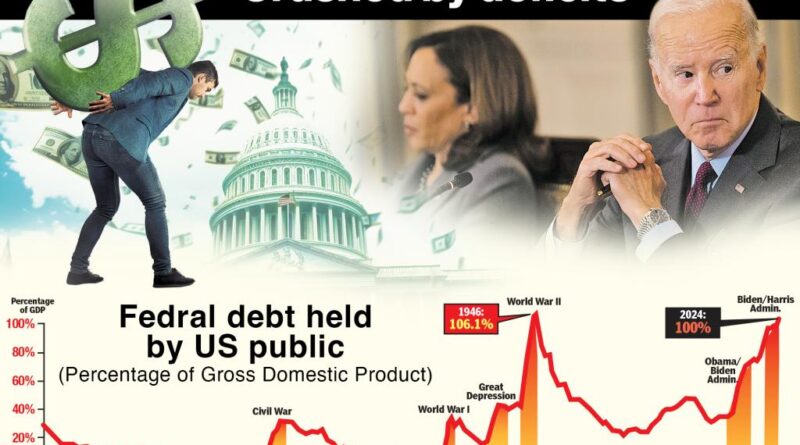Debt reaches highest level since WWII, accounting for 100% of GDP

The presidential campaign season is once again turning politicians into pandering game show hosts, promising voters huge tax cuts and spending expansions with no regard to the debt crisis these policies will accelerate.
Budget deficits are set to exceed $2 trillion this year — despite relative peace and prosperity — and then surge to $4 trillion within a decade under current policies.
For the first time since the end of World War II, the federal debt will top 100% of the gross domestic product.
The impending completion of the Biden-Harris administration brings an opportunity to assess their role in these rising deficits.
Joe Biden and Kamala Harris surely inherited an economic and fiscal mess. President Trump had already signed legislation and executive orders adding $4 trillion to 10-year deficits before the bipartisan pandemic response added $4 trillion more.
Post-pandemic toll
That said, as Biden-Harris entered office, the pandemic-ravaged economy was finally reopening and Americans were returning to work. Thus, the Congressional Budget Office (CBO) forecast that budget deficits — which had temporarily leaped to $3 trillion — would drop back to the pre-pandemic $1 trillion levels as the pandemic aid expired.
Instead, the administration immediately disregarded the advice of even liberal economists and pushed through his $1.9 trillion American Rescue Plan.
Because CBO had calculated that the recovering economy was only $420 billion short of its operating capacity, this $1.9 trillion bazooka wildly overshot its economic stimulus purpose.
Consequently, just as economists warned, the excessive stimulus overheated the economy and contributed three more percentage points to an inflation rate that was already rising due to past pandemic stimulus and supply constraints.
Overall, this inflation cost typical families more than $10,000.
Moreover, the American Rescue Plan’s individual expenditures were largely unnecessary. This pent-up Democratic wish list included $350 billion to bail out state budget deficits that did not actually exist, a bloated union pension bailout, and a decade’s worth of additional federal school funding — all sold to the public with added unemployment benefits, taxpayer rebates and child tax credits.
$28.2 TRILLION OWED
The Biden-Harris administration’s spending spree did not stop there. It also signed $1.4 trillion in new spending in omnibus appropriations bills, $620 billion in student loan bailouts, $520 billion for new veterans’ benefits, a $440 billion infrastructure law, a semiconductor bill, and $360 billion in new SNAP and health spending forced through by executive order.
The offsetting savings promised in the Inflation Reduction Act and Fiscal Responsibility Act are unlikely to materialize.
Adding it all up and including the resulting interest costs brings the total to more than $5 trillion in new 10-year costs enacted under President Biden.
And that bloated figure would have been even higher had the Supreme Court not blocked an even larger student loan bailout, and had a Democratic Congress not reached its breaking point and blocked the original “Build Back Better” proposal costing $2.3 trillion.
Nearly all of this spending occurred during the first two years of Biden-Harris administration, before inflation-weary voters staged their own intervention and elected a Republican House in late 2022.
Thus, instead of the pandemic’s conclusion returning budget deficits to $1 trillion as CBO had projected, the Biden-Harris spending pushed the deficit back up to $2.8 trillion in 2021, and approximately $2 trillion this year.
The results are shocking:
- CBO-projected deficit for the cumulative 2021-2031 period has jumped from $14.5 trillion to $21.3 trillion — reflecting an additional $6.8 trillion in deficits.
- Last year’s federal spending level (24% of GDP) and budget deficit (7.5% of GDP) were both the largest in American history outside of wars and recessions.
- The US debt is expected to be $28.2 trillion this year, 100% of the GDP — the highest level since the end of WWII.
- Since 2021, annual interest costs have nearly tripled, from $352 billion to nearly $1 trillion.
- The debt held by public is currently $212,600 per household.
White House gaslighting
Rather than take responsibility for this sea of red ink, the White House gaslit voters by claiming to have reduced budget deficits.
President Biden brags that his $2 trillion budget deficits are $1 trillion below the 2020 pandemic peak of $3 trillion.
Of course, that 2020 figure was a one-time pandemic anomaly that had been preceded by $1 trillion deficits that were expected to return as soon as the economy reopened and pandemic aid expired.
Essentially, the president is treating the previously-scheduled expiration of temporary pandemic spending as his own historic spending cut — and then spending its savings. This gaslighting was rebuked by the fact checkers at the Washington Post with a rare “Bottomless Pinocchio” rating.
Biden’s successor will inherit $2 trillion deficits, soaring interest costs, and Social Security and Medicare’s trust funds approaching insolvency. Truly a dismal fiscal record that leaves Washington closer to a debt crisis.
Brian Riedl is a senior fellow at the Manhattan Institute. Follow him on X @Brian_Riedl.



